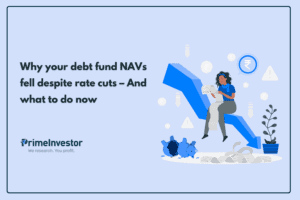The Reserve Bank’s monetary policy on Wednesday served up another repo rate hike of 35 basis points, adding to the 190 basis points through this year. That takes the repo rate to 6.25% from the Covid low of 4%. The key driving factor behind the rapid rate hikes – that of inflation – still remains. The RBI has clearly spelt its commitment to bringing inflation within the target range, even in its latest monetary policy.
But what’s also emerging are signals that the rate hike cycle is drawing closer to the peak. Or, to put it differently, while the RBI has left itself room to raise rates further, the pace and extent of the hikes may not be as blistering as before. From the peak, rates may remain stagnant before eventually shifting back down. This trend is already visible in the yield of 10-year gilt over the past 1.5 months.
In this light, debt fund strategies you have now, to make the most of the current scenario, can be decided based on what you want:
- Buy and hold, to earn from the attractive yields now (called the accrual strategy)
- Take the higher risk and invest in long-term debt funds now, when prices are low, to reap returns when the rate cycle shifts lower (called the duration strategy)

The rate cycle signals
We will give a more detailed outlook on interest rates and debt markets in our 2023 outlook next month – this will be a more overall recommendation on debt opportunities as a whole and not specific to a particular strategy; we’re sticking to debt funds alone in this report. Meanwhile, though, there are a few indicators that point to the rate rise cycle getting into the end-stage.
#1 RBI & inflation indicators
In the latest monetary policy, the RBI continued to stress on the need to bring inflation under control and has aimed to withdraw its accommodative stance to ensure inflation remains within the target. Nor has it changed inflation projections for the rest of the fiscal year or the first quarter of FY-24. It has also revised GDP growth projections marginally lower.
But if all this sounds super-hawkish, there are other trends playing out. One, obviously, is that the quantum of hike dropped from 50 basis points to 35 basis points; this indicates that the sharp earlier increases accounted for the bulk of the rate hikes and further increases can slow.
This apart, the hikes already undertaken need time to take effect on inflation – a factor that had been highlighted in the earlier September policy meeting. That meeting had two members turning cautious on further rapid rate increases, citing the need to watch the impact on both economic growth as well as inflation. The current meeting also had one dissenting voice on hikes, as well as two on withdrawal of accommodative stance. This seems to suggest that the monetary policy committee’s stance is less firmly anchored towards continued increases.
Further, though CPI inflation has been sticky, WPI inflation has begun to cool off which eventually trickles down into consumer inflation. Global commodity prices have corrected and supply chain pressures that were responsible for part of pricey inputs have waned as well. The domestic agricultural outlook has also improved.
This suggests that, while inflation – especially core inflation – is not yet in the RBI’s comfort zone, the weight of the inflation issue has reduced and action may now depend on both incoming data and global factors. The other factor that has been at play are US rates; commentary from the US Fed also appears to suggest a tamer pace of hikes.
Therefore, though there are no explicit signals that the peak rate has been reached, the likelihood of further hikes of the nature we’ve seen thus far stands curtailed. Market reports and economist commentary suggest a further 25-50 basis point increase at most.
#2 Market indicators
Another trend that points towards the rate rise cycle nearing its zenith is yield movements. The bellwether 10-year gilt yield has been shifting downwards in the past few weeks. Bond yields move up during a rising rate cycle and vice versa; since bond markets usually move based on rate expectations and not actual rate action, the falling yield is a sign that markets also do not expect rates to rise much more.
As the chart below shows, the 10-year gilt, after hitting a high of 7.62 mid-year and closing in on that level again last month, has since dropped down to 7.26 levels now. While yields moved slightly higher in the immediate wake of the monetary policy announcement, it settled back lower.
Opportunities in debt funds
It is not possible to perfectly time the rate cycle; it’s best to act when there are more concrete indications over where rates may move. At this juncture, therefore, there are two ways you can play debt funds.
Before we get into these opportunities in debt funds, an important note:
- These strategies are only for any surplus that you wish to invest in debt, or if you’re specifically looking for debt fund options based on the current rate cycle.
- Do not disturb your existing debt fund investments and do not exit for the sake of following such strategies.
- Simply holding on to your current funds will still earn you returns (provided, of course, they are quality funds! Please check the MF Review Tool for our calls on funds).
#1 Buy and hold
This opportunity is for those who would like the steadiness of accrual and who wish to make the most of the current high yields and who have a longer time frame of at least 3 years. For shorter time frames, you have no choice but to stick to categories such as low duration, ultra-short or money market funds.
For longer time frames, one option is to invest in short-duration funds or, if your investment horizon permits, longer-maturity accrual funds such as corporate bond or medium term funds. Yields on these fund categories have significantly improved over the past year (see table below) and can therefore deliver well. Investing in the longer-maturity funds will also benefit should the rate cycle move into a falling cycle down the line.
You can either add to the funds you already hold (if they are Buys in the MF Review Tool) or choose from the Short-Term and Medium-Term categories in Prime Funds.
The other option is to invest in target maturity funds; the recent flood of NFOs in these funds throw up plenty of options. Yields on these funds are similar to that of other debt fund categories above, and give you the advantage of locking into these strong yields. Investments here are best done through lumpsums now rather than SIPs in order to lock into the higher yields. Do bear in mind that these target maturity funds are best aligned with your own investment timeframe as they will mature at the end and money returned to you.
Within target maturity funds, our recommendation is that you go for funds that:
- Have a maturity of 3-6 years – the maturity-yield payoff here is better in these timeframes than the very long timeframes. To take more up-to-date yields, the Bharat Bond series offers perspective (as they are the only funds that declare current yields and not end-of-month). The 2027 gilt Bharat Bond currently has a yield of 7.47%; the 2030-2032 Bharat Bond has a yield of 7.51-7.54%. The spread between the 2032 and the 2027 has also narrowed from earlier.
- Invest in SDLs, either standalone or along with PSU bonds – SDLs offer a better yield that plain gilts and are not much riskier either. For example, based on October data, the average yields of 2027/2028 gilt-only TMFs were around 7.46. SDL and SDL-PSU TMFs were between 7.52 to 7.57%.
The list of funds that meet the above criteria is below; we have removed funds with an AUM of less than Rs 100 crore. You can go for the funds with lower expense ratios. There isn't much of a difference in these fund strategies, just that the ones with SDL can give marginally higher yield. Please note that this is not an exhaustive list and given the spate of NFOs, there could well be other funds that come up.
#2 Play duration
A few months ago, when long-term yields were at highs and returns at lows, we had recommended investing in constant maturity funds through short-running SIPs. This recommendation was intended to make the most of the ‘low’ in the category – similar to buying equity when markets are down – and to hold for the long term.
Now, we are still making the case for constant maturity funds but with a difference. Here is our recommendation:
- As explained above, rates may not move much higher from here – rates are then likely to hold steady for a period but will eventually have to move down. When that turn happens, there are opportunities to make higher returns through bond price appreciation. Therefore, the scenario now appears attractive to get into a duration play by investing at high yields and lower bond prices and book profits down the line.
- This opportunity is best played through very long-term maturity funds of around 10 years –constant maturity gilt funds or 10-year gilt-only target maturity funds. We do not recommend other gilt funds here as there is no control over what maturity these funds will maintain.
- Lumpsum investments are preferrable to SIPs; you can at best stagger lumpsums over the next 2-3 months.
This strategy needs a higher risk appetite as it involves a bet on bond price movements. It also needs you to be vigilant and book profits when returns come in, which also means that you cannot really earmark it towards a particular goal. This holds even if you invest in a TMF; the call here is not to hold to maturity but to book profit or exit on a bond price rally. Note that the rate cycle heading lower is not a near-term call; you will have to hold for a longer period.
An indicator that you can track is the return you earn on the fund. If the compounded annual return since your investment is in single digits or double digits, it may be time to begin booking profits. For example, gilt fund 1-year returns in 2019 when the rate cycle began to fall shot all the way up to 16%.
Our recommendation in constant maturity gilt funds is in the Very Long Term section of Prime Funds. For target maturity funds, the table below lists those with a 9-10 year maturity that invest only in gilts.
To summarise, while the RBI has its sights firmly set on bringing inflation under control and has the leeway to raise rates further, the bulk of the rise is now behind us. This offers opportunities if you’re looking for specific debt fund strategies to take advantage of the current rate scenario. If you do not have a surplus to invest now, there’s no action that you need to take. Simply continue to hold your current debt fund investments; portfolio yields are on the uptick after a years-long low phase which will begin to show up in your returns.




30 thoughts on “Debt fund strategies for the current rate scenario”
Hello Ma’am,
In the duration strategy you are recommending
10 year standalone gilt only TMF. Can we not invest in 10 year standalone SDL TMF. For e.g
Kotak Nifty SDL Apr 2032 Top 12 Equal Weight
as it is offering a better yield. Is it more risky than
the standalone gilt TMF. Please explain, thanks.
We see that you have raised the same query through a ticket, which we have responded to. Thanks, Bhavana
1. How about tracking error for these target maturity funds? Is tracking error details for passive debt funds available on Primeinvestor website?
2. e.g. Bharat Bond ETF April 2030 tracking error was around 0.5% which I believe is high for a debt fund.
Does Fund’s current YTM already reflects this tracking error?
If investor invests looking at current Fund YTM and held till maturity, what is the deviation % possible?
Hello Sir, They are not available as we do not get the direct index data from our data base for most debt indec funds. We expect it will not be low as passive debt funds are not required to hold the exact instrument as the index. Enough it is like to like. But if the volumes on such instruments vary, it can cause higher deviation. As long as passive debt funds deliver equivalent to active counterparts (higher in some cases) it is good enough. thanks, Vidya
Thanks Vidya for your revert. Understood that tracking error can be big with respect to index. So tracking error becomes important when everyone talks of just yield curve.
But regarding my 2nd question, how about possibilities of current Fund YTM (which is a selling point for TMF) being not achievable as actual returns even though fund held till maturity? If yes than What factors can contribute to difference between current fund YTM and actual returns at the end of maturity?
e.g. one of the factor I see (i may not be entirely correct) mostly 5% of TMF portfolio is held in money market instruments which is offering better yield in current scenario but may not be the case in future.
if held to maturity the returns must reflect the yield less expenses that you locked into. Only some huge disruption such as very high redemption can disrupt this. Vidya
Hello Bhavna, Nice article. While you mention that existing investments (for 4-7 year duration angle) should not be touched , here are my specific questions : 1) If my Ultra ST funds have finished 3 years and I don’t need them for 4 years, should i just leave them OR redeem and move to TMF with 4 year maturity ? 2) I have loads of ST and corporate bond funds in the 5-7 year category which are also coming to 3 years. Again, should i move them to TMF or leave if not needed for 4-5 years?
Thanks
A long term portfolio should have a mix of ultra short, short and medium duration funds, especially if the corpus is large. To that extent, there is no need to exit the ultra short fund. You can hold them as long as you have other longer duration funds (which you seem to have). thanks, Vidya
Bhavana,
Many thanks for the insightful post.
I have couple of doubts on Target Maturity Funds:
(i) NAV changes – Does the NAV change only on account of the interest received in the fund from the securities held by the fund? Effectively, if I buy the fund 3 months down the line, I would have not lost anything – because the interest earned has been added to the fund NAV price that I paid for acquiring units and the YTM stated in the fund factsheet will be realized by me if I hold it till maturity. Or NAV also changes due to changes in Bond Prices (which ideally should not because we are holding everything till maturity – but I don’t know how it works – hence asking)
(ii) ‘Realizable – investor’ YTMs for Target Maturity Funds that one may wish to invest in now.
Is it dependent on the NAV acquisition price that an investor who enters the fund mid-way pays? (Confused as there are 3 parameters now – Bond Price, Bond YTM, Fund NAV. ) Or is the Fund YTM, NAV agnostic?
Can the Investor YTM and Fund YTM be different? (if Investor has paid higher price for getting the fund YTM)? What’s the most reliable & simple way of knowing the Investor Realizable YTM for a Target Maturity Fund? Assumption – entering some months after NFO, holding till maturity.
(iii) Updated Fund YTM, Investor YTM
You have mentioned in the article that:
” Bharat Bond series offers perspective (as they are the only funds that declare current yields and not end-of-month”
So for Bharat Bond series we get Fund YTMs on day-end basis and for others on their factsheet on month-end basis? So Jan 1st week could be a good time to invest.
Again – if Investor YTM and Fund YTM differs then how to get updated Investor YTM
Sorry for the long question. I hope I could present my doubts clearly.
A fund’s NAV reflects the market value of its instruments, which includes bond price movements. It’s also how the fund’s YTM will change – for example, in a rising rate cycle, bond prices will drop causing yields to go up, which will consequently cause the fund’s YTM to go up as well. If you hold the fund till maturity, you will earn close to the YTM that prevailed at the point you invested in the fund, netting off factors like expenses.
As far as YTM data goes, unfortunately, it’s hard to get up-to-date info. Some AMCs such as Edelweiss update the info through the month. Others may do it in their fortnightly debt portfolio updates. Otherwise, it would typically be in the first 2 weeks of a month when month end portfolio/factsheet info is published by the AMC. – thanks, Bhavana
Comments are closed.